Intriguing and Exceedingly Rare Baker City, Oregon 2-Ounce “Slug”
Issued in 1907; The Eliasberg Specimen
Undated (1907) Baker City, Oregon 2-Ounce Gold “Coin” or “Slug”. K-2 (p. 379). Rarity-8. Genuine (PCGS)
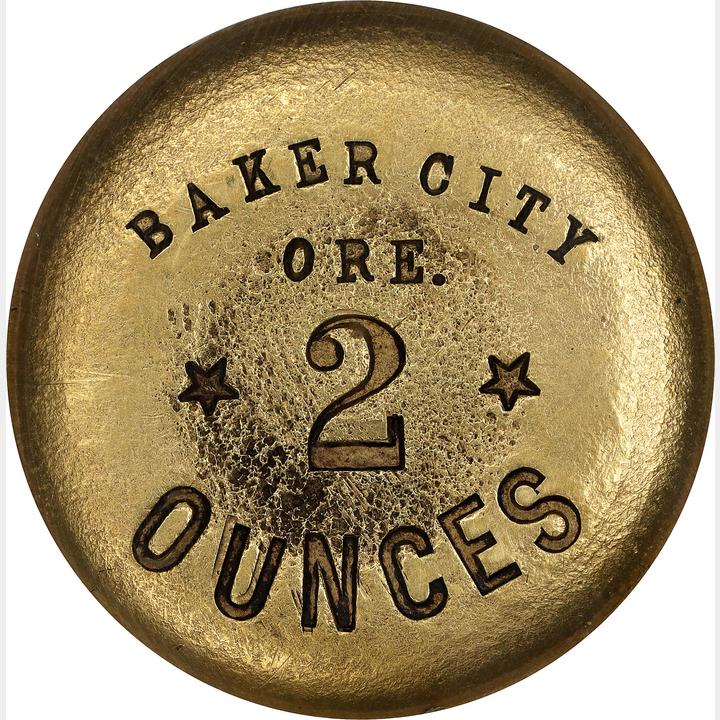
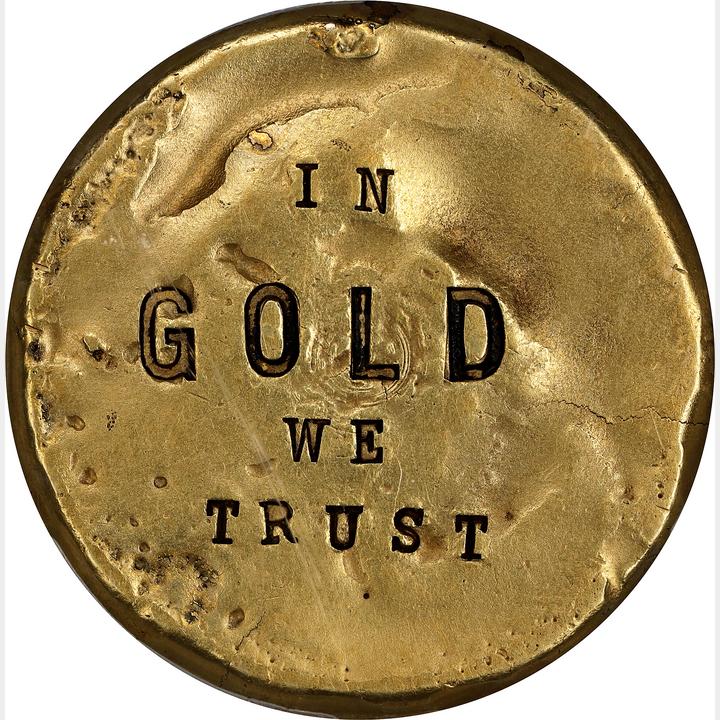
A Mint State specimen, virtually as issued, with handsome medium gold color. Doubtless, no finer example of this fascinating type exists. The inscriptions were all hand-punched. Thus, even at the time of issue no two examples were precisely alike. The obverse reads BAKER CITY / ORE. / (star) 2 (star) / OUNCES, each individually punched, with repunching evident at the letters UN in OUNCES. The motto IN / GOLD [larger letters] / WE / TRUST stands alone on the reverse. Natural casting imperfections are concentrated in the center of the obverse, more widely distributed throughout the reverse, the latter side with faint cracks in the ingot at 3:30 and 7 o’clock. There are no distracting marks, and we mention a couple of extremely faint grazes at 9 o’clock on the obverse solely as additional identifiers.
At least one other variety exists, dated 1907:
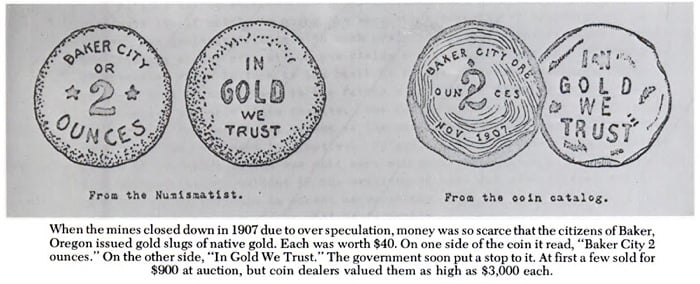
In 1906-1907, the annual reported gold production in Oregon amounted to over $1 million annually, as it had for some time before. Within the state there were about 280 producing mines of which about 200 were placers (pronounced “plassers”; these were gold flakes and nuggets found in stream beds and ancient alluvial deposits). Baker County was the most productive in terms of value of gold obtained, with most of the metal coming from quartz and other siliceous ores. Jackson County had the most placer deposits. In Baker County districts included Austin, Baker, Burnt River, Cable Cove, Clarks Creek, Connor Creek, Cornucopia, Cracker Creek, Durkee, Geiser, Paddy Creek, Rye Valley, Sumpter, Virtue, and Weatherbee. Oregon gold production was not the stuff of which adventure stories were made, and while the larger strikes in California and the Klondike captured the public’s imagination, little national press was given to the Baker County deposits. Today, gold is still to be found there, and in 1978 our own Q. David Bowers visited a derelict gold dredge which had operated at Sumpter a few years earlier.
Regarding the Baker City ingots of 1907, the following account appeared in The Numismatist, March 1908:
Gold Coins of Home Manufacture Circulate in Baker City.
Baker City, in Eastern Oregon, is nothing if not original. When currency became somewhat scarce in other parts of the country [during the financial recession of 1907], the whole thing was treated as a huge joke by the business men of that part of the state. The banks went right along paying out ‘real money’ to their depositors as if a scarcity of circulating medium was the least of their troubles, and looking over the gold bearing hills of the surrounding landscape, exclaimed. ‘Ah, ha,’ if not, ‘oh ho.’ At least that is the way the average Bakerite puts the case, now that the rest of the state has caught its breath and things financial are again normal.
A week or two after the ‘squeeze’ was in full blast two or three Baker City citizens conceived the idea of issuing ‘gold currency’ on their own hook, and evolved a plan of manufacturing 2-ounce slugs, or buttons, of native gold, which, of course, could not bear the stamp of the government, but could be worth their weight just the same. Fred Mellis, a mine owner, and James Howard, ex-president of the bank at Sumpter, are said to be responsible for a design used on these slugs, a number of which were hammered out of pure gold and which weighed somewhere near two ounces. The effect of having these slugs passed around Baker city had a good effect on the people, for the natural inference was produced that as long as the mines of Eastern Oregon could produce the precious metal in $20 chunks there was not need of getting alarmed over a scarcity of circulating medium.
W.G. Ayers, the ‘sheep king’ of Baker County, who is a visitor in Portland, has one of these buttons which he bought at its weighing in value and a trifle over, desiring to hold it as a souvenir commemorative of the faith the people of his section of the state entertain of their ability to meet emergencies.
The obverse has the words stamped into it with a stencil die, ‘Baker City, OR., 2 Ounces,’ and the reverse the words, ‘In Gold We Trust.’
It is believed that only 100 of these provisional “coins” were issued, as reported on page 379 of Donald H. Kagin’s important reference Private Gold Coins and Patterns of the United States (1981). Undoubtedly, most of these were melted years ago. Prior to our (Bowers and Merena’s) offering of the present specimen in the May 1996 Eliasberg Collection sale, Dave Bowers had never handled an example in some 40 years in the rare coin business, and had only ever seen one other, that being an example owned by Abner Kreisberg and Jerry Cohen circa the 1960s.
The Kreisberg-Cohen specimen may have been one owned by Virgil Brand. The Brand ledger includes the entry: “baker city / gold / $100 / cost $100 / from T.E. Leon 1909 / sold august 1/1938”. The $100 denomination given here is a bookkeeping error and should read $2, for elsewhere in the Brand papers is the actual record of sale for a 2-ounce Baker City ingot on August 1, 1938, through Burdette G. Johnson. Earlier, B. Max Mehl offered one of the Brand specimens to John Work Garrett, and there is a rubbing of this example in the Garrett papers. It is of a different design than the Eliasberg piece offered here (and also different from the example attributed as Kagin-1), with BAKER CITY OREGON on one line arcing above 2 / OUNCES in the center and the date NOV. 1907 below. Additionally, the motto IN / GOLD / WE / TRUST appears in larger letters on the reverse of the example in the Garrett papers.
Our 1996 offering of the Eliasberg specimen elicited a letter to Dave Bowers from a California client who owned a similar piece. Around the same time Dave heard that the Bancroft Library at Berkeley, California had a specimen, but was unable to confirm it. Research by Saul Teichman located an offering for a specimen in the Guttag Brothers’ sale of October 1927, lot 889, described in part as:
(1907) Baker City, Oregon. Two ounce gold button shaped slug. Inscription: BAKER CITY, ORE. 2 OUNCES. Rev. IN GOD WE TRUST.
The prior provenance of the Eliasberg specimen is unknown and, indeed, it is not possible to reconcile all known and rumored examples. It seems likely, however, that no more than five or six different specimens could be traced across at least three different types. All are intriguing and exceedingly rare numismatic relics from a gold-producing region that is often overlooked by collectors, but which still played a significant role in the history of the American West.
This lot includes a custom large blue Capital Plastics holder created for this ingot as part of the Eliasberg Collection. The holder is available to the winning bidder upon request to Stack’s Bowers Galleries at the close of the auction.
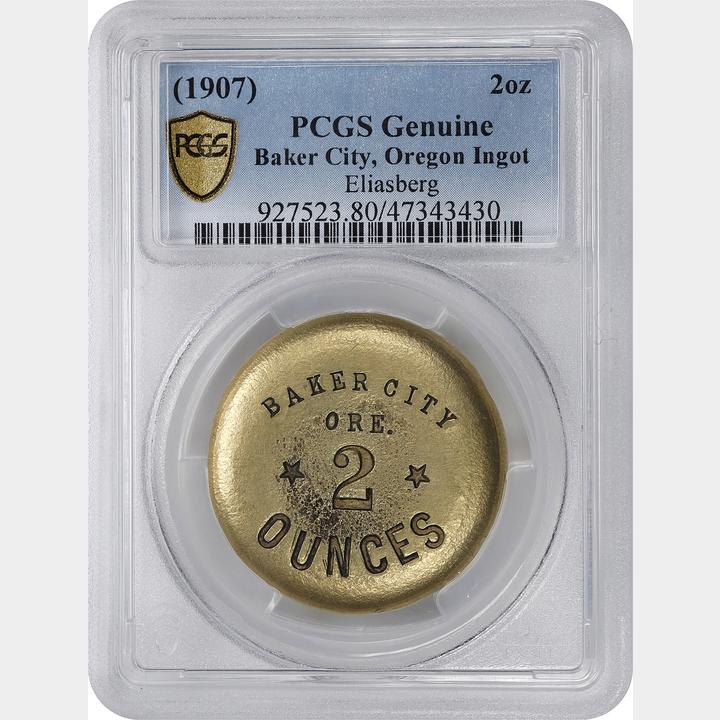
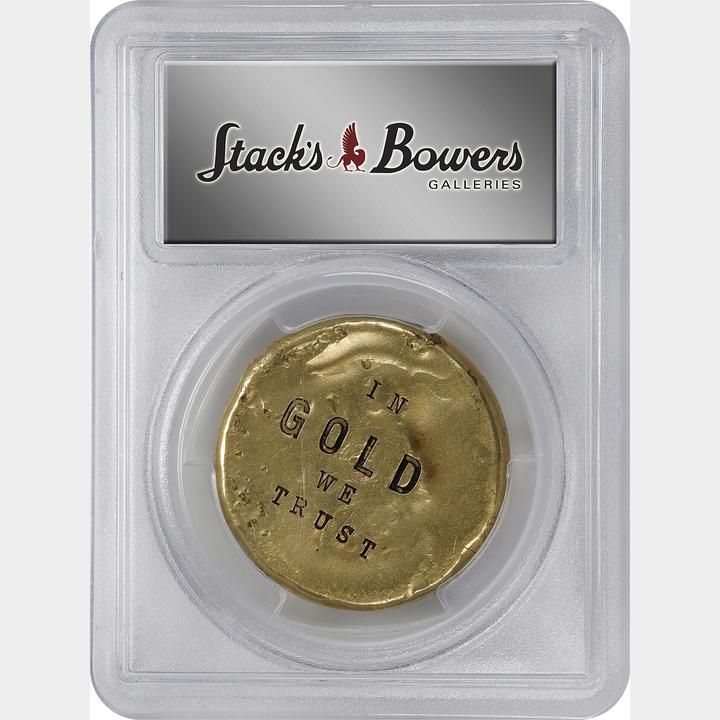
Provenance: From the Louis E. Eliasberg, Sr. Collection. Earlier from our (Bowers and Merena’s) sale of the Louis E. Eliasberg, Sr. Collection, May 1996, lot 386.
[11/2023] https://auctions.stacksbowers.com/lots/view/3-15VT13/undated-1907-baker-city-oregon-2-ounce-gold-coin-or-slug-k-2-p-379-rarity-8-genuine-pcgs ($114,000)
The following photo was taken at the Bank of California Money Museum in San Francisco showing 2 examples side by side different from the auctioned example at Stacks Bowers.
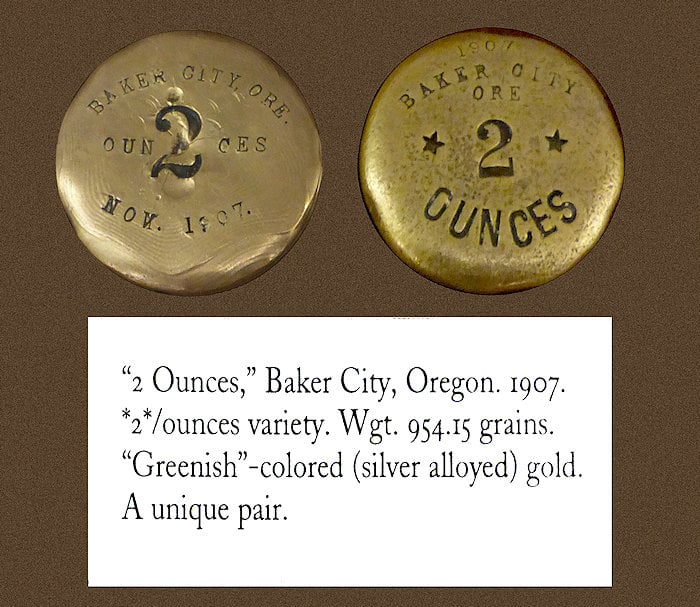
2 oz, 1907, Round Gold Bar, Baker City Oregon.
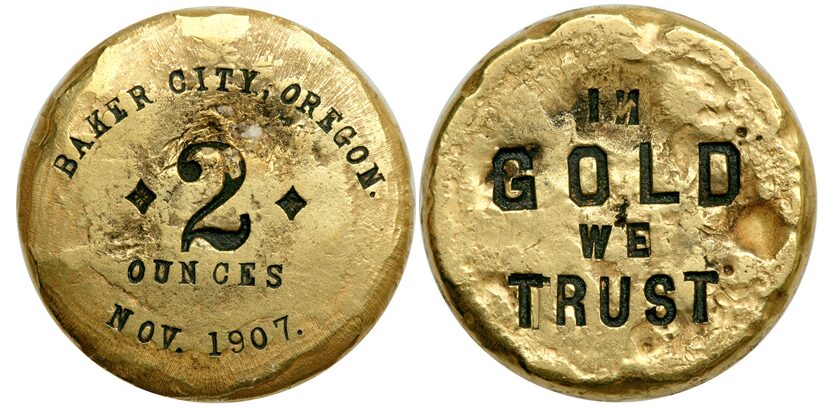
34. mm., 59.5 gr. Obverse stamped: Baker City, Oregon, 2 Ounces (flanked by two diamonds) Nov. 1907. Reverse stamped: In GOLD WE TRUST. Further study is recommended.
Estimated Value $2,200 – 2,500.
Ex R.E. Naftzger, Jr. Collection. Accompanied by an envelope marked in Ted’s hand in green ink “B.G. Johnson, St. Louis to S.M. Koeppel, 1938 to REN”
[02/2010] http://images.goldbergauctions.com/php/lot_auc.php?site=1&sale=57&lot=2752&lang=1 ($11,788)
